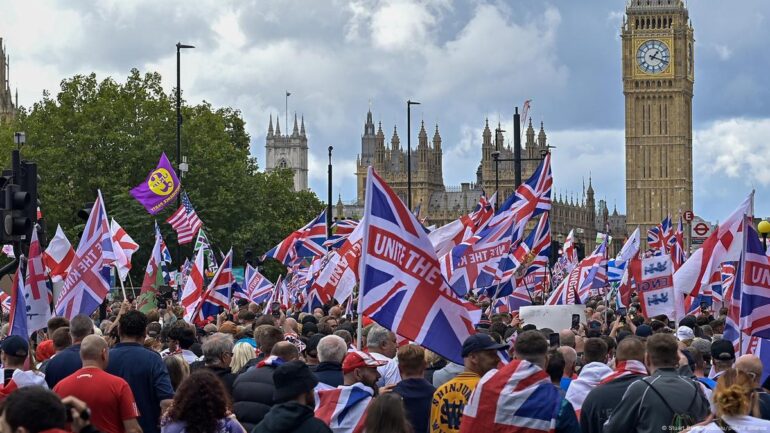On Saturday, September 13, 2025, London saw one of its largest protests in recent times, with an estimated 110,000 to 150,000 people joining the “Unite the Kingdom” rally organized by far-right activist Stephen Yaxley-Lennon, known as Tommy Robinson. The event, centered on anti-immigration and free speech themes, turned chaotic as some attendees clashed with police, resulting in injuries and arrests. A smaller counterprotest, the “March Against Fascism” organized by Stand Up To Racism, drew about 5,000 people, adding to the tension in the city.
A Charged Atmosphere
The “Unite the Kingdom” rally saw thousands of participants waving the Union Jack and St. George’s red-and-white flag of England. Some carried signs with messages like “stop the boats” and “send them home,” reflecting the rally’s strong anti-immigrant sentiment. Chants of “we want our country back” echoed through the crowd, which stretched nearly a mile from Big Ben to beyond Waterloo train station. The event was fueled by growing public debate over immigration, particularly the issue of migrants crossing the English Channel in small boats, with over 28,000 arrivals recorded this year alone.
Tommy Robinson, a prominent figure in Britain’s far-right movement and founder of the anti-Islam English Defence League, framed the rally as a defense of free speech. However, much of the rhetoric focused on immigration, with speakers like French far-right politician Eric Zemmour promoting the controversial “Great Replacement” theory, which claims white Europeans are being deliberately replaced by non-white immigrants. Elon Musk, appearing via video link, criticized the U.K.’s left-leaning government, warning of a “rapidly increasing erosion of Britain” due to “uncontrolled migration.”
Clashes and Police Response
While much of the rally remained peaceful, violence broke out on its fringes. A small group of Robinson’s supporters clashed with police, who were working to keep the protesters separated from the counterdemonstrators. The Metropolitan Police reported that 26 officers were injured, four seriously, with injuries including broken teeth, a possible broken nose, a concussion, and a spinal injury. Some protesters threw bottles and engaged in physical and verbal abuse, attempting to breach police barriers. At least 25 people were arrested for offenses like violent disorder, assault, and criminal damage, with more arrests expected as investigations continue.
“There is no doubt that many came to exercise their lawful right to protest, but there were many who came intent on violence,” said Assistant Commissioner Matt Twist of the Metropolitan Police. Over 1,000 officers, some equipped with riot gear, were deployed to manage the massive crowd and maintain order.
Counterprotest and Tensions
The “March Against Fascism” counterprotest, organized by Stand Up To Racism, saw around 5,000 participants chanting “refugees welcome” and “smash the far right.” The two groups were kept apart by police barriers, but tensions flared as some “Unite the Kingdom” supporters tried to break through to confront the counterprotesters. One incident involved a man with blood on his face being escorted away by police, though the cause of his injury was unclear.
The counterprotest highlighted a deep divide in public sentiment. While Robinson’s supporters called for stricter immigration policies, counterprotesters condemned the rally’s rhetoric as hateful and xenophobic. The presence of international far-right figures, like Germany’s Petr Bystron and France’s Zemmour, underscored the rally’s broader anti-immigrant agenda, which resonated with some attendees but alarmed others.
A Nation Divided
The rally comes amid heightened national debate over immigration and free speech. This summer, anti-immigrant protests outside hotels housing asylum-seekers turned violent in some areas, fueled in part by incidents like the conviction of an Ethiopian man for assaulting a teenager in a London suburb. The proliferation of U.K. and English flags across streets and lampposts has been seen by some as a sign of national pride and by others as a symbol of rising nationalism.
The event also paid tribute to Charlie Kirk, a U.S. conservative activist recently killed, with a moment of silence and a bagpiper playing “Amazing Grace.” Signs mourning Kirk’s death, including one reading “Freedom of speech is dead. RIP Charlie Kirk,” reflected the rally’s broader narrative of declining free speech in the U.K. This sentiment was amplified by recent controversies, such as the arrest of comedian Graham Linehan for online comments and the government’s labeling of Palestine Action as a terrorist group, which sparked criticism over restrictions on free expression.
A Broader Context
The “Unite the Kingdom” rally was significantly larger than expected, dwarfing the counterprotest and even surpassing many recent demonstrations, though it fell short of the 300,000-strong pro-Palestinian march in London in November 2023. Robinson, who has a history of legal troubles, including a recent jail term for contempt of court, described the rally as “the spark of a cultural revolution.” Supporters like Sandra Mitchell echoed his call, demanding an end to “illegal migration” and expressing faith in his leadership.
As immigration remains a dominant issue in British politics, outpacing concerns about the economy, the rally underscores the country’s polarization. While Robinson’s movement has gained traction, mainstream anti-immigrant parties like Reform UK have distanced themselves from him due to his criminal record and polarizing rhetoric. Meanwhile, Prime Minister Keir Starmer’s government faces growing scrutiny over its handling of both immigration and free speech debates.
The events of September 13 highlight the challenges of balancing free expression, public safety, and social cohesion in a deeply divided nation. As investigations into the violence continue, the rally serves as a stark reminder of the tensions shaping the U.K.’s political landscape.
